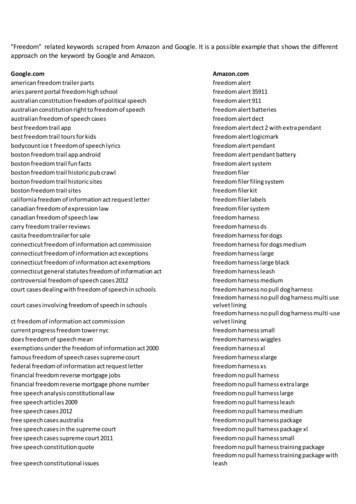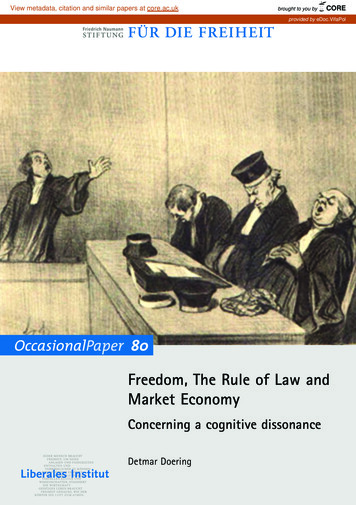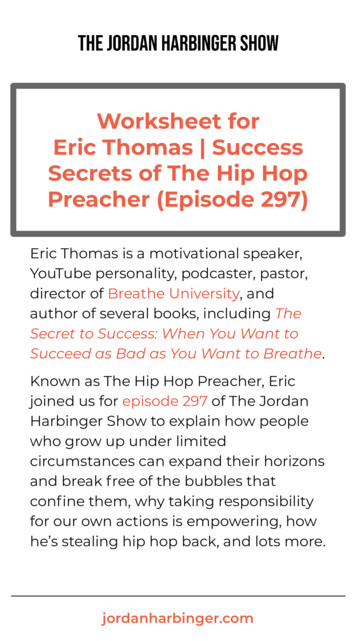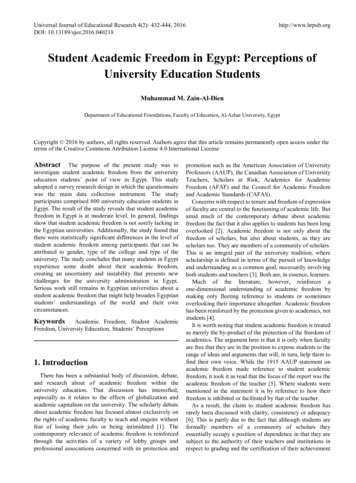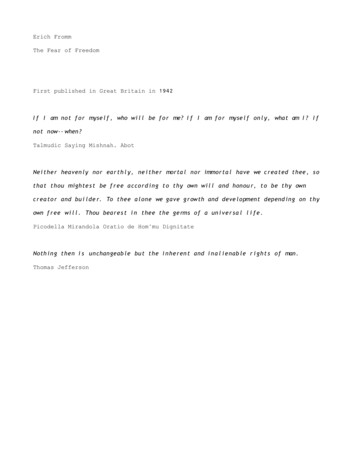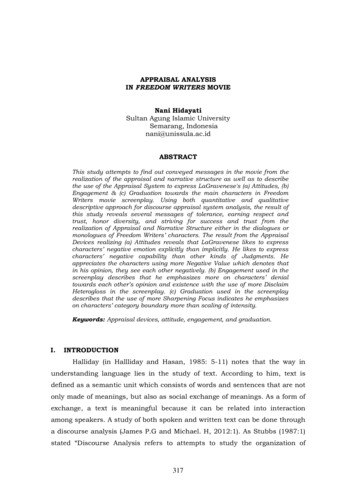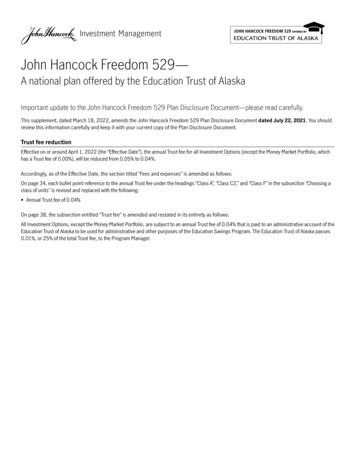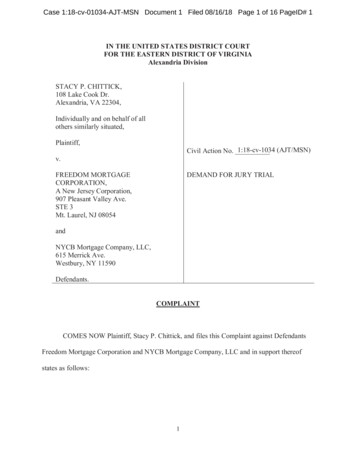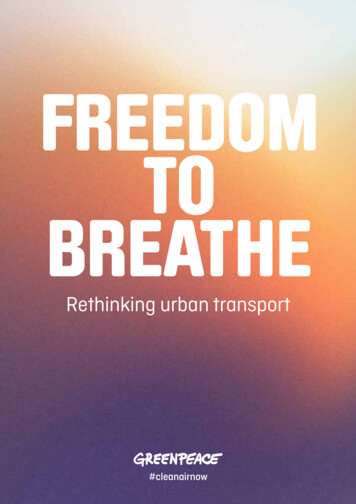
Transcription
FREEDOMTOBREATHERethinking urban transport#cleanairnow
FREEDOM TO BREATHE RETHINKING URBAN TRANSPORTTraffic jam in Singaporerush hourSource: epSos.de/Wikipedia2
FREEDOM TO BREATHE RETHINKING URBAN TRANSPORT3To create healthy, flourishing cities where peoplecan live free from the health problems associatedwith air pollution and to protect our climate wemust virtually eliminate vehicles run on fossilfuels from our roads and radically rethink ourapproach to the way we move around our cities.This document builds on A New Urban Mobility Concept, a report that was published by GreenpeaceGermany and Jan Gehl Architects. It is available to download at: www.greenpeace.de (pdf)
FREEDOM TO BREATHE RETHINKING URBAN TRANSPORT4FREEDOM TO BREATHE: RETHINKING URBAN TRANSPORTCreating sustainable urban transport systems willsatisfy our desire for freedom of movement, whiledramatically reducing the impact the transportsector has on both human health and the planet.Phasing out diesel and petrol engines will makeour cities greener, quieter and healthier places tolive. Putting people, not cars, at the centre of urbantransport planning, will not only transform cityliving, it will also help protect the climate.While air pollution affects children and elderlypeople the most, the respiratory and cardiovasculardiseases it triggers can be damaging and evenfatal at any age. In Europe alone (where recentnumbers are available), air pollution from allsources is responsible for nearly half a millionpremature deaths every year1 – with a vast numberattributable to road transport.Meanwhile, the climate crisis is unfolding at analarming speed. The Paris Climate Agreementstates that we need to limit the rise in global meantemperature to well below 2 C and as close aspossible to 1.5 C. To meet our climate goals andtackle air pollution, we have to address one of themain root causes: fossil fuel powered vehicles.The way forward is clear. To create healthy,flourishing cities where people can live free fromthe health problems associated with air pollutionand to protect our climate we must virtuallyeliminate vehicles run on fossil fuels from ourroads and radically rethink our approach to theway we move around our cities.PEOPLE OVER CARSRedeveloping our cities to prioritise people, insteadof prioritising cars, will help create better placesfor people to live. Residents, commuters, touristsand workers will be more likely to reach theirdestinations without wasting time in pollutingtraffic. A combination of people walking, cyclingand using renewable-powered public transportwill mean that people can move through quieter,cleaner and healthier cities.Sharing electric vehicles, rather than owningthem, would free up space that could then betransformed into parks and green areas. In someof the world’s cities, vast areas are surrenderedto cars. In urban areas of Los Angeles County, anestimated 14% of land – 200 square miles – isdedicated to parking.2An increase in shared vehicles would not only helplower emissions, it would mean that more placesfor relaxation and recreation could be created,resulting in cities that are more people-centredand promote greater social interaction. Healthier,happier communities can emerge where noisy,polluting fossil-fuelled traffic once stood.Car free days in New York were created tohelp New Yorkers “imagine a cleaner, safercity with more public transportation, morewalking, more public space, and fewer cars”.3The event has proven to be hit with NewYorkers, giving people a taste of what it’slike to enjoy their city without the worry ofbreathing highly polluted air.1 European Environment Agency, Air Quality in Europe 2016 Report – EEA Report No. 28/20162 Journal of the American Planning Association, 2015, 81(4), pp. 268-286. Report available 4363.2015.1092879?journalCode rjpa203. From Car Free Day NYC website: http://www.carfreeday.nyc
FREEDOM TO BREATHE RETHINKING URBAN TRANSPORTVolkswagen’s Autostadt,WolfsburgSource: pexels.com5
FREEDOM TO BREATHE RETHINKING URBAN TRANSPORT6BETTER AIR QUALITY AND OPTIMUM URBAN SPACE:TWO SIDES OF THE SAME COINDiesel and petrol engines are one of the main sources already lives in cities, with this number expectedof urban air pollution – and the main reason nitrogento increase to 66% by 2050. Unless more is donedioxide (NO2) limits are still exceeded in so manyto enable people choose greener transport optionsEuropean cities. Electric vehicles, on the other hand, – like buses, trains, walking and cycling – ourare far better suited to urban settings. They are much cities will face further congestion and pollution aspopulations rise.quieter, emit no exhaust fumes and are much moreefficient. And their engines use much less energyThe current system, where privately owned carswhen driven in a stop-and-go driving pattern, whichdominate global transport, is also remarkablyoften occurs in cities as a result of heavy traffic.inefficient. It is estimated that the average car isonly used 5% of time.6 As tens of millions of carsA massive shift away from fossil fuel vehicles toare manufactured each year, a vast amount ofelectric would lead to a much needed transportnatural resources are being used to make vehiclesrevolution. But changing cars alone is not enough.that sit idle on driveways or streets 95% of the time.As the use of electric vehicles increases, these carsmust be powered by clean energy. And crucially, weneed to transform our cities so that we use cars less.Until recently, New Road in the centre ofIn Copenhagen, a city with hundreds ofkilometres bike lanes, 62% of residents chooseto cycle to where they work or study4 – a figurethat’s risen 12% since 2015. Cyclists andpedestrians have right of way at intersections,making the city very convenient for biking.The world is projected to have 41 mega-citieswith more than 10 million inhabitants each by2030.5 Meanwhile, 54% of the world’s populationBrighton, UK was a little noticed side street.But in the course of extensive alterations, NewRoad was turned into a shared street and publicspace where people can spend downtime ormeet up with others. New Road complementsneighbouring destinations frequented by thegeneral public and has become one of the busiestspots in town. The transformation resultedin: 93% less traffic, 175% more pedestriansand 600% more time spent in the street.74. Copenhagen City of Cyclists – facts and figures (2017). Published by the Cycling Embassy of openhagen-city-cyclists-facts-figures-2017/5. United Nations data: ion/world-urbanization-prospects-2014.html6. Calculation by reinventingparking.org: -parked-95-of-time-lets-check.html7. Statistics from Cities for People (2010), by Jan Gehl. Published by Island Press: https://islandpress.org/book/cities-for-people
FREEDOM TO BREATHE RETHINKING URBAN TRANSPORT7THREETRANSFORMATIVESTEPSA global shift away from privately owned cars to walking, bicycles, shared electric vehicles and publictransport would not only reduce pollution and help improve human health – it would lead to much betteruse of the planet’s resources.1REDUCE EMISSIONSCities can promote shared ownership of electric vehicles by, for example, providing more chargingpoints and offering reserved parking space. Powering electric vehicles with renewable energy willminimize emissions even further. Consolidating deliveries will avoid needless movement of vehicles.And switching to electric cargo bikes (human powered vehicles designed and constructed specificallyfor transporting loads) will immediately decongest the streets. Giving priority to pedestrians andcyclists will encourage people to make the switch to healthy, low cost, zero-emission transport.2 DEVELOP INFRASTRUCTURE TO PROMOTE QUALITY OF LIFECities need efficient and renewable energy powered public transport available to all. Reducingspeed limits for motor vehicles and prioritising public space for use by people and publicservices will create a less stressful environment for people to move about in. This means reallocating existing space away from cars (garages, parking) and towards people (pedestrianand cycling paths, green areas). Car free zones, or zones where only emergency services,delivery vehicles and public transport are allowed will improve the experience of city living.3 REINVIGORATE CITY CENTRES WITH NEW SERVICESCar free zones, new forms of public transport available to everyone and the development of integratedmobility services will make city centres more vibrant. This means integrating the networks of varioustransport modes and linking them with public spaces and destinations; routes therefore can betravelled from end to end using several different modes of transport – which can be easily switchedbetween. Such integration should include a single ticketing system for all modes of public transportand simplified tariff systems. We must design new mobility services that encourage the use ofgreen mobility over the use of one’s car. Bicycle and vehicle sharing should also be promoted.
FREEDOM TO BREATHE RETHINKING URBAN TRANSPORTSome cities have already started reinventingtheir urban transport systems. In October 2017,the Mayor of Paris announced that France'scapital city will take further action to tackletraffic congestion and air pollution. On topof existing plans to ban diesel cars by 2024,Paris's Mayor has now proposed to do thesame with petrol fueled cars by 2030. So longas this announcement is followed through,programs to encourage alternative forms ofmobility - such as new cycle paths and publictransport - will encourage Parisians to takejourneys that are currently made by car.Electric vehicle (EV) chargingstation in Sunsuria CityTownship, Sepang, MalaysiaSource: pexels.com8
FREEDOM TO BREATHE RETHINKING URBAN TRANSPORT9SIX GUIDING PRINCIPLESFOR URBAN DECISION MAKERSCutting transport demand within city centres is key to enabling cities to support a greater populationwith the highest possible quality of life. We can achieve this by reducing urban sprawl, and creating morecompact and more efficient hubs – with space for homes, workplaces, shops and leisure that keep travelneeds to a minimum. Though shifting to sustainable transport will require a different approach from cityto city, here are six areas that should be addressed.1 PROXIMITY4 ENJOYMENTUrban services, such as leisure, shoppingand education, will need to serve anincreasingly diverse population. They mustbe located close to the people who use themand all modes of urban transport must becoordinated to make them accessible.Urban spaces must be designed to meethuman needs, to stimulate us to takeadvantage of all the opportunities a city offers.The identity of special neighbourhoods withtheir heritage and history can be preservedand enhanced. Recreation in all forms,from relaxation to social opportunities,must be attractive and easily available.2 CONVENIENCEAccess to urban amenities and services mustbe easy and convenient for all, including thosewith physical impairments. Infrastructureshould be uniform so users can immediatelyrecognise and make use of its functions. Suchinfrastructure must include the appropriateshelters at waiting points, traffic lightcontrol prioritising pedestrians and cyclists,bicycle racks close to highly frequenteddestinations, and the ability to reserveshared services, such as bicycles, online.3 CONNECTIONSPedestrians and cyclists must have accessto a continuous network of direct routes thatconnect public transport, places of work,schools and other destinations of daily life.5 SAFETYPublic and non-motorised modes of transport,including walking and cycling, must be safefrom traffic, crime and violence and musttake health aspects into consideration.Increasing safety in turn will promote theattractiveness of cleaner modes of transport.6 PROMOTING SUSTAINABILITYCampaigns and education will helpencourage public and private sectors, aswell as individuals, to collaborate and shareresources to work out what changes need tobe made and how to implement them in orderfor city living to become truly sustainable.
FREEDOM TO BREATHE RETHINKING URBAN TRANSPORT10A VISION TO INSPIREIt is clear that with technological and social changes, cities can eliminatefossil fuel powered vehicles, rapidly reduce pollution and help findsolutions to climate change. But for a truly sustainable future, moreinnovative and inspiring city designs are also needed to promote thehealth of individuals as well as healthy social interaction. Major cities canpioneer this change, leading the charge toward more sustainable urbanspaces. In turn this will shape national and global debates on the futureof urban transport, blazing a trail toward a greener and healthier world.Lapse Photo of man ridinga bicycleSource: pexels.com
CONTACT: Barbara Stollbarbara.stoll@greenpeace.orgGreenpeace is politically and financially independent.Greenpeace exists because this fragile Earth deserves a voice.It needs solutions. It needs change. It needs action!Greenpeace InternationalOttho Heldringstraat 51066 AZ AmsterdamThe Netherlands
This document builds on A New Urban Mobility Concept, a report that was published by Greenpeace Germany and Jan Gehl Architects. It is available to download at: www.greenpeace.de (pdf) To create healthy, flourishing cities where people can live free from the health problems associated with air pollution and to protect our climate we
